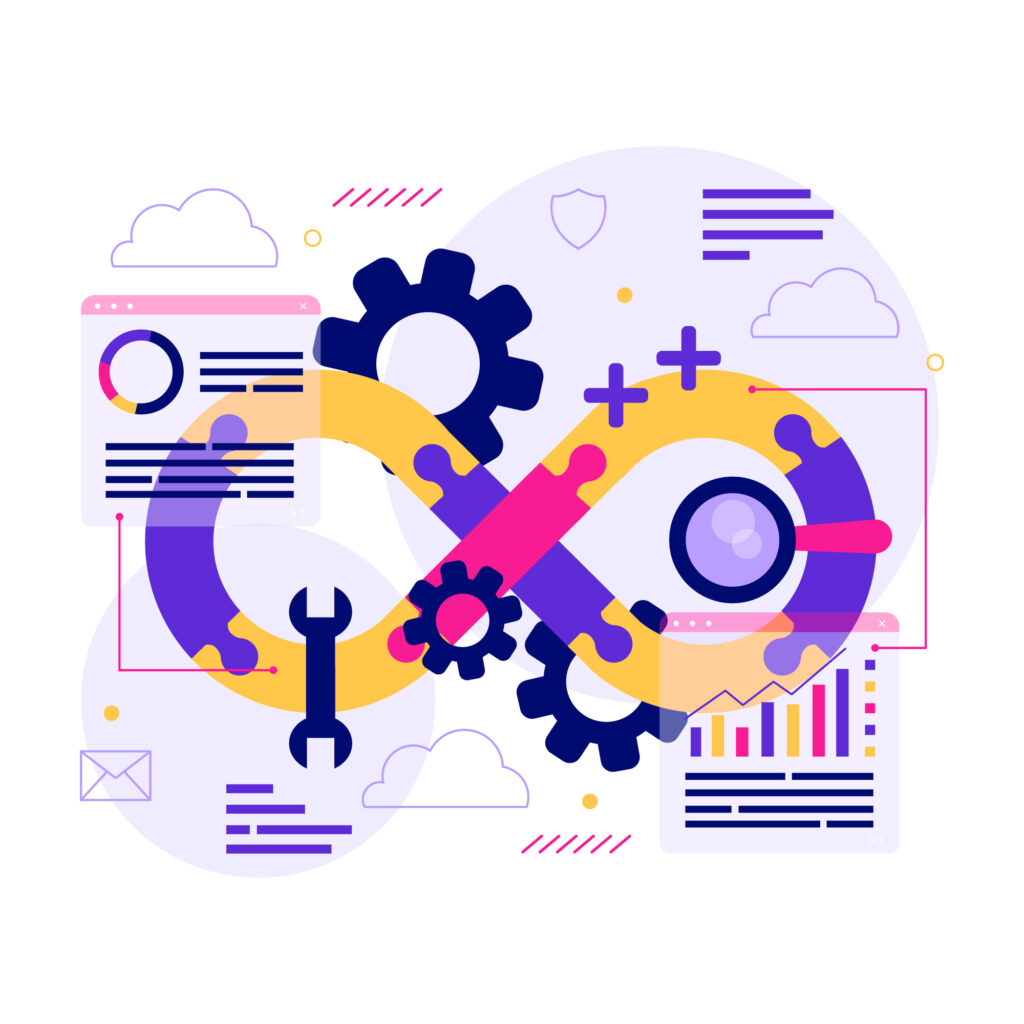Devsecops Tools are becoming a beacon for modern age security. Security breaches have been on the rise, with a 15% increase. This has made organizations realize the importance of a security focused approach. To deal with the predicted rise in cyber threats, businesses need to adopt this approach.
DevSecOps is a valuable tool for CIOs to address vulnerabilities during the production stage, and it reduces the time to market. A recent survey found that 90% of organizations are making progress in their DevSecOps journey. 42% of them are planning to have a full implementation within the next year.
Stages of DevSecOps
Improving security in development involves automated security checks at various CI/CD pipeline stages, forming a DevSecOps pipeline. Regardless of the CI/CD platform, the automated security stages integrate smoothly into the DevSecOps methodology, enhancing the workflow. Let’s delve into the five security stages of the DevSecOps pipeline.
Stage 1: Software Composition Analysis
This process is done after code compilation:
Software Composition Analysis (SCA) examines open source code in organization repositories, identifying vulnerabilities and potential conflicts with licensing policies. Given the prevalence of open-source components in applications, SCA is crucial. It should run in the pipeline post coding, and the pipeline configuration should promptly halt if any SCA issues arise.
Stage 2: Static Application Security Testing (SAST)
Static Application Security Testing (SAST) scrutinizes the entire code base, pinpointing vulnerabilities, including those outlined in the critical OWASP Top Ten. Configured to operate post-coding and implementation in the SDLC, the SAST tool publishes results and halts the pipeline if security standards are not met.
Stage 3: Container Scanning
After creating container images:

Container scanning involves examining container images for vulnerabilities, ensuring the safety of custom applications run on container orchestration platforms. This process identifies bugs in dependent libraries, highlights licensing changes, and is executed post-build, before uploading new container images to a repository. If vulnerabilities are detected, the build fails, preventing the image from being uploaded.
Stage 4: Dynamic Application Security Testing (DAST)
After deployment to a test environment:
Dynamic Application Security Testing (DAST) simulates a rogue user by crawling and attacking a running application, identifying issues such as XSS and TLS certificate verification problems. Executed post-deployment to a test environment, DAST ensures a thorough examination of the application’s security.
Stage 5: Interactive Application Security Testing (IAST)
During automated or manual tests:
Interactive Application Security Testing (IAST) identifies and manages security risks uncovered during dynamic or runtime testing. Using software instrumentation, IAST employs agents and sensors deployed in running applications. It continuously analyzes interactions during automated or manual testing, detecting vulnerabilities in real-time.
IAST is effective in identifying issues like encrypted data, file system vulnerabilities, and database access problems. It should be conducted post-deployment to a test or local environment while automated or manual tests are underway.
What Are DevSecOps Tools?
DevSecOps combines development, security, and operations in a collaborative software development model. It emphasizes continuous collaboration throughout the software development lifecycle (SDLC) to achieve faster, high-quality, and secure software releases.

A crucial element of DevSecOps is the secure continuous integration/continuous deployment (CI/CD) pipeline, leveraging automation for enhanced development speed. While DevOps focuses on rapid, quality code releases, DevSecOps integrates security practices.
DevSecOps tools play a vital role by tightly integrating security into the CI/CD pipeline, automating numerous security processes. These tools facilitate the infusion of security across the entire development lifecycle, breaking down silos between DevOps and security teams. Implementation involves incorporating security best practices and testing tools at every stage.
DevSecOps tools aim to achieve three primary goals:
- Firstly, minimize risk without slowing down velocity: Implement continuous security testing to detect and address vulnerabilities, ensuring security without impeding development speed.
- Secondly, support security teams with automation: Enable security teams to secure development projects without the need for manual review and approval at each release.
- FInally, shifting security left: Automate security tasks to initiate them earlier in the development lifecycle, enhancing proactive security measures.
DevSecOps tools fall into various categories based on their functionality:
- Firstly, static Application Security Testing (SAST) Tools
- Secondly, dynamic Application Security Testing (DAST) Tools
- Thirdly, software Composition Analysis (SCA) Tools
- Container Security Tools
- Infrastructure as Code (IaC) Security Tools
- Continuous Integration/Continuous Deployment (CI/CD) Security Tools
- Compliance and Governance Tools
- Finally, security Dashboard and Analytics Tools
Automation: Devsecops Tools
Automation plays a crucial role in modern development pipelines, enabling DevSecOps teams to seamlessly integrate security across all development phases without hindering the pipeline. Explore various automation tools for your DevSecOps pipeline:
1. CodeAI
CodeAI employs deep learning technology to automatically discover and rectify security vulnerabilities in your source code. QbitLogic, the creator, trained the solution using millions of actual bug-fix samples, aiding developers in identifying and solving security issues.
2. Parasoft Tool Suite:
Parasoft offers a suite of tools automating various aspects of development security testing:
- C/C++test: Identifies defects early in the development cycle.
- Insure++: Detects erratic programming and memory-access errors.
- Jtest: Designed for Java software development testing.
- dotTEST: Complements Visual Studio tools with advanced coverage and deep static analysis.
3. Red Hat Ansible Automation:
Ansible, an open-source IT automation engine, reduces repetitive manual work, enhancing consistency, reliability, and scalability. Ansible automates tasks such as provisioning servers, configuration management, and application deployment in DevOps pipelines.
4. StackStorm:
porcessStackStorm is an event-driven platform for runbook automation, supporting infrastructure as code (IoC). Using “if-then” rules, it simplifies workflows by triggering events, checking rules, running instructions, and executing commands.
StackStorm is valuable for tasks like automated remediation and security responses in site reliability engineering (SRE) teams.
Container Security Tools:
Container security technology plays a crucial role in ensuring the secure set up and absence of vulnerabilities in containers, container images, and related components. Explore various container security tools:
1: Calico Open Source
Project Calico, an open-source initiative, has evolved into Calico Open Source, widely adopted for container networking and security. It powers over 1.5 million nodes daily across 166 countries. Calico is a versatile networking and security solution.
It is one of the best solutions for containers, virtual machines, and native workloads, supporting platforms like Kubernetes, OpenShift, Docker EE, OpenStack, and bare metal services.
2. Clair
Clair aggregates data from various vulnerability sources, including CVE databases like Ubuntu CVE Tracker, Red Hat Security Data, and Debian Security Bug Tracker. It performs comprehensive static analysis, identifying container vulnerabilities to enhance security.
3. Notary:
While TLS secures communications with web servers, it can’t prevent compromised servers from substituting legitimate content. Notary, based on The Update Framework (TUF), addresses this by allowing publishers to sign content offline using highly secure keys. It prevents malicious content substitution in container repositories, ensuring content integrity.
Cloud Testing Tools
Cloud testing tools furnish dedicated test environments tailored for cloud infrastructure, encompassing essential software-hardware configurations. These tools often seamlessly integrate with DevSecOps tools and align with CI/CD workflows.
1: AppScan on Cloud:
AppScan on Cloud delivers a suite of security testing tools, encompassing dynamic, interactive, and static testing for mobile, open-source, and web applications. It excels in identifying pervasive security vulnerabilities and streamlining the remediation process.
2. AWS Security Service:
Amazon Web Services (AWS) provides an array of security services, including data protection features like encryption, key management, and continuous threat detection. With identity management capabilities, AWS enables scalable management of identities, permissions, and resources.
3: ThreatModeler:
ThreatModeler is designed to assist enterprises in efficient security risk management. The Cloud Edition automatically constructs threat models for cloud infrastructures, adept at handling potential threats across various cloud environments, including AWS and Microsoft Azure.
Application Security Testing Tools
Application Security Testing (AppSec) tools are essential for DevSecOps, ensuring application security before production release. These include Static Application Security Testing (SAST) tools for early code analysis, Dynamic Application Security Testing (DAST) tools for realistic tests, and Test Automation software to streamline testing tasks, minimizing manual effort in the process.
1. Veracode
Veracode Static Analysis is an SAST tool capable of examining software libraries in various frameworks and languages without needing source code access. This allows the analysis of proprietary code and external components.
Veracode offers an API for integrating static analysis with CI/CD tools, supports inclusion in IDEs, build systems, and task management systems. The Pipeline Scan feature helps scan new code commits, prioritize security flaws, and compare with previous scans, facilitating the identification of the version introducing a new security issue.
2. Checkmarx CxSAST
This is a static analysis tool within the Checkmarx Software Exposure Platform. It focuses on identifying security vulnerabilities in custom and open-source code across over 25 languages. Key features include ensuring compliance with industry regulations, fixing code vulnerabilities.
It is an easy use tool for developers of varying skill levels, and an incremental scan capability to examine only modified or new code.
3. SonarQube
The tool employs continuous inspection to oversee code quality. This open source tool is compatible with over 25 programming languages, seamlessly integrating into existing workflows. It provides a visual representation of your application’s health, pinpointing newly identified issues.
DevSecOps teams use SonarQube for swift detection and resolution of code errors, ensuring a balance between security and quality.
4. Fortify WebInspect
Fortify WebInspect is a dynamic application security testing (DAST) tool designed to uncover and prioritize exploitable vulnerabilities in web applications.
Key features encompass:
- Firstly, functional Application Security Testing (FAST) – Conducts functional tests similar to IAST, without restrictions on specific functionality.
- Secondly, black box testing insights – Mimics a hacker’s approach, scanning a live application to identify client-side frameworks, version numbers, and potential vulnerabilities.
- Compliance management – Incorporates predefined policies and reports for various compliance standards, such as PCI DSS, HIPAA, NIST 800-53, ISO 27000, and OWASP Top Ten.
- Finally, API support – Scans both SOAP and REST APIs, finding API functionality through Swagger, OpenAPI, or Postman, unveiling potential API security vulnerabilities.
5. New Relic
The tool offers a viewing platform for gathering data from diverse sources, aiding in a comprehensive understanding of software and providing insights for improvement.
Key advantages of New Relic include:
- Firstly, centralized data – Instrumentation of information across the technology stack is enabled through agents, APIs, and integrations.
- Secondly, data analysis – The platform allows unified data analysis through a single UI, using New Relic’s query language to identify root causes of issues.
- Finally, threat detection – New Relic employs machine learning to proactively identify and explain anomalies, preventing them from reaching critical levels.
6. ELK with Kibana
The ELK Stack comprises three open-source tools—Elasticsearch, Logstash, and Kibana (ELK). It aids in identifying server or application issues by centralizing logging with Logstash, searching data with Elasticsearch, and visualizing data through Kibana.

The tools complement each other, with Kibana offering viewing, interactive dashboards, geospatial data views, and graph features for complex queries, along with search and interaction capabilities with data in Elasticsearch directories.
Top OpenSource tools DevSecOps
Software Composition Analysis (SCA) Tools:
- Firstly, OWASP Dependency-Check: Identifies known weakness in project dependencies.
- Secondly, retire.js: Scans for vulnerable JavaScript libraries in web applications.
- Thirdly, whiteSource Bolt: Scans project dependencies for issues and offers remedy steps.
- Dependency-Track: Monitors project dependencies, providing insights into known vulnerabilities.
- Finally, OSSIndex: Integrates with development tools to offer real time security intelligence on project dependencies.
Static Application Security Testing (SAST) Tools:
To ensure that your code is secure and free of vulnerabilities, there are several open-source platforms and tools that you can use for continuous code quality inspection and static code analysis.
- Firstly, SonarQube is a reliable platform that includes static code analysis to identify security vulnerabilities.
- Secondly, Bandit is a SAST tool that focuses on analyzing Python code for common security issues.
- Thirdly, SpotBugs is an open-source static analysis tool that helps to find coding errors, vulnerabilities, and performance issues in Java applications.
- Another recommended tool is RIPS, an open-source PHP security analysis tool that effectively finds issues and coding flaws in PHP applications.
- Lastly, PMD is an open-source source code analyzer for languages like Java, JavaScript, and XML. It is designed to detect bugs and security vulnerabilities.
Dynamic Application Security Testing (DAST) Tools:
To help you identify vulnerabilities and perform security audits on your web applications, here is a list of open-source web application security scanners that you can use:
- Firstly, OWASP ZAP is a web app security scanner that uses a proxy to intercept and inspect traffic between the client and the server. It can identify various security vulnerabilities.
- Secondly, Nikto is a web server scanner that performs comprehensive tests to find potential vulnerabilities.
- Thirdly, Wapiti is a web app vulnerability scanner that performs black-box testing for security audits.
- Fourthly, Arachni is a modular open-source web app security scanner that checks for a broad range of vulnerabilities and offers detailed reports.
- Lastly, Grabber is a web app scanner that finds issues through crawling and scanning web pages.
Container Security Tools:
- Clair: Open-source container vulnerability scanner analyzing images and creating issue reports.
- Trivy: Open-source vulnerability scanner for containers, OS packages, and dependencies. Offers detailed reports on detected vulnerabilities, including severity and remediation steps.
- Anchore Engine: Open-source tool for analyzing container images, and identifying issues, policy violations, and best practices.
- Sysdig Falco: An open-source behavioral activity monitoring tool that’s specifically designed for containers and Kubernetes. It detects anomalous behavior and security threats in real-time, using rules and policies to define expected container behavior and trigger alerts for changes.
Infrastructure Security Tools:
- OpenSCAP: Open-source framework for compliance checking and issue management, viewing and securing infrastructure systems.
- Lynis: Open-source security auditing tool evaluating the security setup of Linux and Unix-based systems.
- Dagda: Open-source container security analysis tool conducting static analysis of container images to identify security issues and vulnerabilities.
- ScoutSuite: Open-source multi cloud security auditing tool viewing the security posture of containerized infrastructure in public cloud environments.
Compliance Tools:
- OpenSCAP: Security Content Automation Protocol (SCAP) framework for compliance checking, vulnerability management, and measurement.
- OpenVAS: Full-featured issue scanner finding security weaknesses in systems and networks.
- Wazuh: Open-source host based intrusion detection system (HIDS) aiding compliance monitoring, file integrity monitoring, and log analysis.
Dashboard Tools:
- Grafana: Open-source analytics and monitoring platform for customizable dashboards to view various metrics and data sources.
- Kibana: Open-source data viewing dashboard for Elasticsearch, used to explore, analyze, and view data stored in Elasticsearch indices.
- Metabase: Easy-to-use open source business intelligence and analytics tool creating dashboards and view data from various sources.
Vulnerability Tracking Tools:
- OWASP DefectDojo: Open-source issues management tool for tracking and managing issues in applications and infrastructure.
- TheHive: Open-source incident response and case management platform with features for tracking and managing issues.
[Want to learn more about Devsecops Tools and its importance in your business? Click here to reach us.]
Conclusion
DevSecOps tools and stages are vital for a high end security approach in software development. With Threat Modeling, Security Testing, Analysis, Remediation, and Monitoring, DevSecOps integrates security easily.
SAST, DAST, IAST, and an efficient pipeline ensure secure and agile application development. Embracing DevSecOps is important for meeting compliance standards and earning consumer trust in the dynamic software landscape. With the help of an advanced DevOPs support team such as Bobcares you can use it as an excellent tool for your business.
PREVENT YOUR SERVER FROM CRASHING!
Never again lose customers to poor server speed! Let us help you.
Our server experts will monitor & maintain your server 24/7 so that it remains lightning fast and secure.








0 Comments